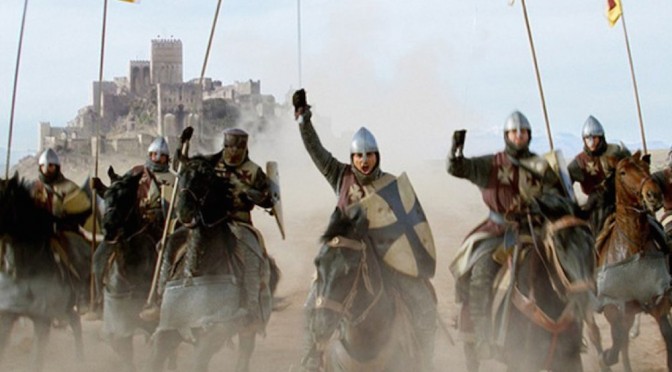Nationalism
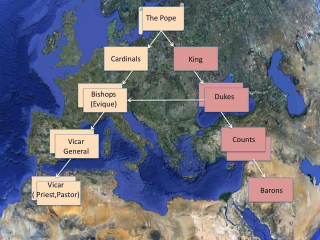 The Pope of the time developed the concept of right to rule. He maintained that Roman Emperor Constantine the Great had given the Popes of Rome the right to the temporal rule of the Western Empire. This was ultimately supported by documentation known as the “Donation of Constantine” (which much later was proved to be one of the greatest forgeries and therefore frauds, of all time). Nevertheless the Pope used this concept to intervene and appoint the untrustworthy devious, murderous, teenage leader of the Frankish tribe to be his Magister Militarum. A cursory examination of the titles chosen for the new Church of Rome hierachy shows that it was the Church itself which was intended to provide the civil governance.
The leader of the Franks was called Clovis and the Dynasty he founded the Merovingians.
There are many legends about why the Pope, chose Clovis, but it was really because he permitted the Church of Rome to adopt, at least in the short term, the role it had assigned to itself - to become the spiritual and temporal ruler of the Western Empire. Clovis became the classic Client King. His job was simply to use his ruthless political and military skills to eliminate the opposition, which he did, with brutal efficiency.In the 14th Century it is extremely doubtful whether Europeans identified themselves with any particular nation. They might see themselves as Gascon, Breton or Angevin, perhaps even as Béarnaise, Armagnac, Savoyard or Provencale but not as French Or Occitan. The formation of the state of Aragon, the Scottish declaration of independence and the Frankish invasion of the lands of Occitan, all signalled the end of feudalism and the introduction of concepts of nationalism.
The Pope of the time developed the concept of right to rule. He maintained that Roman Emperor Constantine the Great had given the Popes of Rome the right to the temporal rule of the Western Empire. This was ultimately supported by documentation known as the “Donation of Constantine” (which much later was proved to be one of the greatest forgeries and therefore frauds, of all time). Nevertheless the Pope used this concept to intervene and appoint the untrustworthy devious, murderous, teenage leader of the Frankish tribe to be his Magister Militarum. A cursory examination of the titles chosen for the new Church of Rome hierachy shows that it was the Church itself which was intended to provide the civil governance.
The leader of the Franks was called Clovis and the Dynasty he founded the Merovingians.
There are many legends about why the Pope, chose Clovis, but it was really because he permitted the Church of Rome to adopt, at least in the short term, the role it had assigned to itself - to become the spiritual and temporal ruler of the Western Empire. Clovis became the classic Client King. His job was simply to use his ruthless political and military skills to eliminate the opposition, which he did, with brutal efficiency.In the 14th Century it is extremely doubtful whether Europeans identified themselves with any particular nation. They might see themselves as Gascon, Breton or Angevin, perhaps even as Béarnaise, Armagnac, Savoyard or Provencale but not as French Or Occitan. The formation of the state of Aragon, the Scottish declaration of independence and the Frankish invasion of the lands of Occitan, all signalled the end of feudalism and the introduction of concepts of nationalism.
The driving force behind the switch from feudalism was bto impose loyalty to the lowest levels of society “you are french” bound everyone to the state and was much more cohesive than “You have sworn fealty to the seigneur of St Agnes”
In Occitan the extermination of the local counts who had their own rather different ideas about national identity and their replacement with northerners, raised great resentment.
However it took nearly the whole of the 14thcentury for the concept of nationhood to be understood and applied and not everyone embraced the concept: particularly not the inhabitants of Occitan.
Frankish Origins
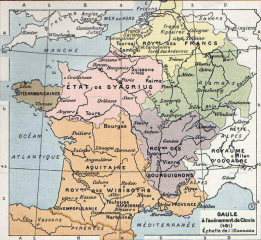 The "kingdom" of Syragius When Clovis was chosen by the Popeas the new leader of the Western Empire Clovis was in control of only a small faction of what is now France.
The "kingdom" of Syragius When Clovis was chosen by the Popeas the new leader of the Western Empire Clovis was in control of only a small faction of what is now France.
When Clovis had completed his agreement with the Church of Rome he co-operated with Syagrius and with the help of the mysterious Ambrosius they worked together to curb the ambitions of the Visigoths.
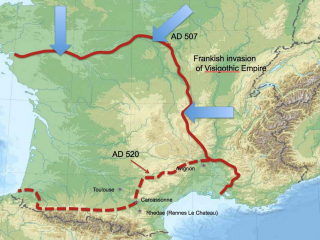 All Clovis's contemporaries including the remnants of the roman empire were inclined to the "Arian" version of Christianity, which was in fact what became known as The cathar religion. it became Clovis sacred task to conquer the arian homelands and impose the beliefs of the Church of Rome. First Siagrius was defeated. then clovis turned his attention to the Visigothic Kingdom. Possibly this taught Clovis the limitations of both ally and enemy. He defeated Syagrius, and then turned his attention to the Visigoths.
All Clovis's contemporaries including the remnants of the roman empire were inclined to the "Arian" version of Christianity, which was in fact what became known as The cathar religion. it became Clovis sacred task to conquer the arian homelands and impose the beliefs of the Church of Rome. First Siagrius was defeated. then clovis turned his attention to the Visigothic Kingdom. Possibly this taught Clovis the limitations of both ally and enemy. He defeated Syagrius, and then turned his attention to the Visigoths.
There is a strong possibility that everything was complicated by the presence of British Romans or British High Kings, but there is no doubt about the outcome.
Clovis Victory
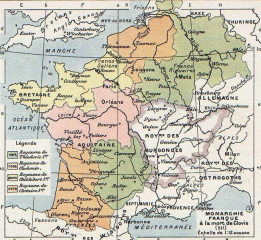 Subdivision after Clovis death By the time of Clovis’ relatively early death in 511 the Franks controlled over one third of the Western Roman Empire, including most of greater Occitan and a large portion of what is now Germany.. The Frankish expansion was facilitated by two factors; their acceptance of the feudal allegiance of existing landowners, and the use of the Church of Rome to provide administrative and legal support to Clovis’s government.
Subdivision after Clovis death By the time of Clovis’ relatively early death in 511 the Franks controlled over one third of the Western Roman Empire, including most of greater Occitan and a large portion of what is now Germany.. The Frankish expansion was facilitated by two factors; their acceptance of the feudal allegiance of existing landowners, and the use of the Church of Rome to provide administrative and legal support to Clovis’s government.
The Church of Rome was able to spread it’s influence throughout Clovis’ kingdom and was given the ability to raise taxes to support it’s activities and the building of churches. However a tradition developed whereby all Frankish possessions were divided between the king’s sons. Each son was established in his own kingdom and felt free to establish whatever laws and practices seemed appropriate to their own realm.
From the very first sub division the south west corner of Occitan was established as a separate kingdom and under the influence of the local lords a unique set of laws was developed to reflect the Visigothic heritage. In Aquitaine the racial mix and the the religious beliefs of the people supported changed little. The church of Rome protested at the special treatment but was unable to prevent a tradition of passive resistance against it’s proclamations and wealth gathering .
Negotiating rights
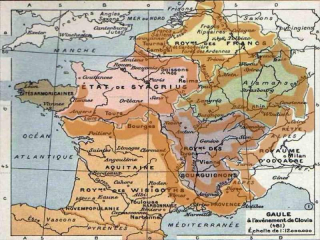 The feudal system, as introduced by Clovis, relied on the oath of allegiance. Of course allegiances can be changed. Even before Clovis conquest and certainly in the negotiations during the conquest itself the Comtes whose property lay close to borders were taught an important lesson.They learned that though they were exposed to risk of attack across the border they also had the ability to change their allegiance and therefore were able to negotiate either side of the border for advantageous terms.
The feudal system, as introduced by Clovis, relied on the oath of allegiance. Of course allegiances can be changed. Even before Clovis conquest and certainly in the negotiations during the conquest itself the Comtes whose property lay close to borders were taught an important lesson.They learned that though they were exposed to risk of attack across the border they also had the ability to change their allegiance and therefore were able to negotiate either side of the border for advantageous terms.
The Marcher Territories
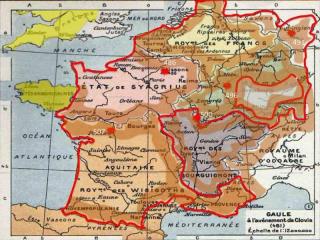 Clovis’ conquest did not remove the border areas. By his failure to fully conquer either the Alamans or the Burgundians, plus the interfaces created with Gascon, Breton and Visigothic lands Clovis had created an Empire which had literally thousands of miles of border territories. These became known as marcher territories.
Clovis’ conquest did not remove the border areas. By his failure to fully conquer either the Alamans or the Burgundians, plus the interfaces created with Gascon, Breton and Visigothic lands Clovis had created an Empire which had literally thousands of miles of border territories. These became known as marcher territories.
Frankish Inheritance
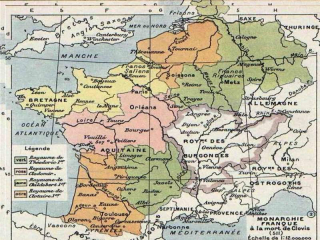 The Franks had a tradition of dividing all property equally amongst children. Also traditionally their leader had been acclaimed by popular vote. Clovis, probably influenced by the Church of Rome; who would have disliked the uncertainty of a popular vote, appointed his sons as rulers but subdivided the Kingdom between them. This was not peaceful co-existence. They warred with each other.
The Franks had a tradition of dividing all property equally amongst children. Also traditionally their leader had been acclaimed by popular vote. Clovis, probably influenced by the Church of Rome; who would have disliked the uncertainty of a popular vote, appointed his sons as rulers but subdivided the Kingdom between them. This was not peaceful co-existence. They warred with each other.
Shifting Boundaries
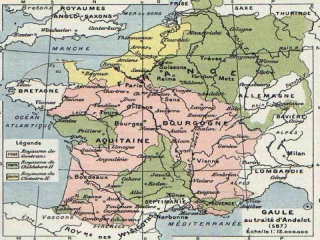 Another set of marcher territories was produced and another set of landowners were introduced to the concept of shifting allegiances and negotiating beneficial terms. And so it progressed, each generation produced a new subdivision of the realm and a greater and greater proportion of the Comtes and Barons learned the value of shifting alliances.
Another set of marcher territories was produced and another set of landowners were introduced to the concept of shifting allegiances and negotiating beneficial terms. And so it progressed, each generation produced a new subdivision of the realm and a greater and greater proportion of the Comtes and Barons learned the value of shifting alliances.
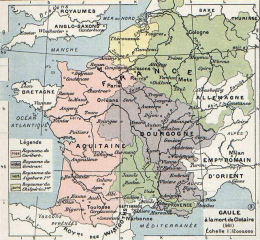 Clotaire's expansionThis pattern continued for the next hundred years. The system was very different, as the individual kings fought with each other,often brutally about territorial and trading rights but were all considered heirs to the total frankish conglomeration, thus Chlothar I, who was initially “King of Aquitaine” became became “King of the Franks” which included Aquitaine.
Clotaire's expansionThis pattern continued for the next hundred years. The system was very different, as the individual kings fought with each other,often brutally about territorial and trading rights but were all considered heirs to the total frankish conglomeration, thus Chlothar I, who was initially “King of Aquitaine” became became “King of the Franks” which included Aquitaine.
Brunhilda
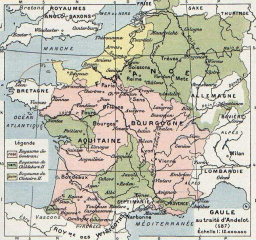 The treaty of AndelotWhat is not immediately obvious is that a strip of land bordering the Gulf de Lion remained in Visigothic hands. This was initially known as “Septimania”, possibly because veterans of the seventh legion were settled there in Roman times. it eventually became known as “Gothia” because of the high incidence of people with Visigothic parentage.At Clotaire’s death the total empire was again subdivided but on this occassion the subdivision combined Aquitaine with Neustria, the “homeland” of western Frankia. Clotaire left for his new home in paris leaving behind a vacuum filled with squabbles between the counts and the church about levels and ownership of taxation rights.
The treaty of AndelotWhat is not immediately obvious is that a strip of land bordering the Gulf de Lion remained in Visigothic hands. This was initially known as “Septimania”, possibly because veterans of the seventh legion were settled there in Roman times. it eventually became known as “Gothia” because of the high incidence of people with Visigothic parentage.At Clotaire’s death the total empire was again subdivided but on this occassion the subdivision combined Aquitaine with Neustria, the “homeland” of western Frankia. Clotaire left for his new home in paris leaving behind a vacuum filled with squabbles between the counts and the church about levels and ownership of taxation rights.
The subdivision of the lands always represented attempts to find a negotiated equality in the value of the land and opportunities to raise taxation. The treaty of Andelot represented an attempt to reunify all the Frankish nations.
It was driven by a most remarkable lady, Brunhilda, a visigothic princess who married Sigibert I of Austrasia. Their eldest son was the future Childebert II. Her sister Galaswintha married Sigiberts brother Chilpleric of Neustria and was given Aquitaine as a dowry, to be granted to her in the event of her husbands death effectively handing back what had been Visigothic land to a Visigothic princess, throwing the true ownership of the whole area into doubt. Chilperic’s mistress Fredegund promptly murdered Galaswintha.
The murder went unpunished, in fact Chilperic married Fredegund and had a son by her, the future Clotair II. Brunhild was furious and persuaded her husband Sigibert to declare war on Chilperic. A third brother, Guntram of Burgundy who was nominally the king of Aquitaine at that time, negotiated a peace and decided that Galaswintha’s dowry should be awarded to Brunhilda,something he was able to do but which once againpur the true ownership of aquitaine in doubt. As an extension of this settlement he accepted Brunhild’s son Childebert as his adopted son. The peace was soon broken and Sigibert was victorious in battle but promptly murdered. Guntram then died and Brunhilda’s son Childebert II became King of all Franks except Neustria.
The war carried over into a second generation and third generations. Before any conclusion was reached Chilebert II died. Brunhilda carried on with the war in the name of her grandson Theudoric. Chilperic’s son Clotair II defeated Brunhilda and executed them both. Brunhilda herself was dragged for miles down a cobbled road and then ripped limb from limb by two teams of horses. Thus Aquitaine found itself again with a new ruler. The prospect of having a Visigoth as an immediate overlord had been welcomed but now it had been changed once again without any consultation. The squabbles became a protest movement.
Charibert II
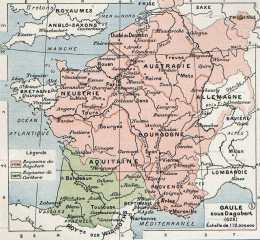 Dagobert I and Caribert There was then an interregnum in Aquitaine but Twenty five years later Clotair II appointed his son Charibert II as King of Aquitaine.
Dagobert I and Caribert There was then an interregnum in Aquitaine but Twenty five years later Clotair II appointed his son Charibert II as King of Aquitaine.
Charibert married Gisela of Gascony who was of Visigothic stock and when he died young only eight years later she became the Duchess(Queen?) of Aquitaine, a truly independent nation.
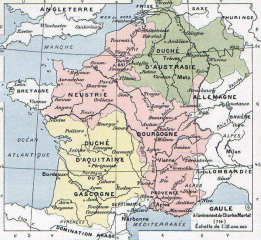 At the time of Charles Martel There followed one hundred and fifty years of Independence for Aquitaine. There is a belief that Boggis, the first ruler after Gisela, was her son.
At the time of Charles Martel There followed one hundred and fifty years of Independence for Aquitaine. There is a belief that Boggis, the first ruler after Gisela, was her son.
Boggis married the daughter of Clotair II(his niece). They broke the Frankish tradition. They inherited control of Aquitaine and only Aquitaine. Their matriarch was from a Visigothic family, they lived in Aquitaine and ultimately split their realm into Comtes, shared amongst their children. Boggis son Eudes called himself the King of Toulouse. His position was reluctantly accepted by the Northern Franks and but for an unexpected event Aquitaine, encompassing two thirds of Occitan would have been permanently established as an independent nation
Moorish Invasion
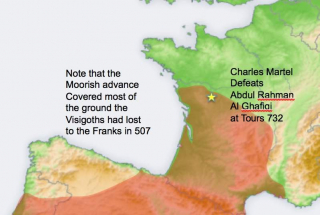 The franks had not a huge population they accepted the feudal allegience of existing landowners, and built elaborate churches through a system of tithes but the beliefs of the people changed little. then the moors invaded from the south. they recognised all "peoples of the Book' and for a critical period prohibited any discrimination because of differences in beliefs.In 719, The Moors invaded from the south. A war of religion in the Visigothic kingdom south of the Pyrenees resulted in Moors being imported from North Africa to act as mercenaries. They only needed a foothold. in an amazingly short eight years they replace Visigothic rule in all but the mountainous north west corner of the Spanish Peninsula. They then moved north of the Pyrenees.
The franks had not a huge population they accepted the feudal allegience of existing landowners, and built elaborate churches through a system of tithes but the beliefs of the people changed little. then the moors invaded from the south. they recognised all "peoples of the Book' and for a critical period prohibited any discrimination because of differences in beliefs.In 719, The Moors invaded from the south. A war of religion in the Visigothic kingdom south of the Pyrenees resulted in Moors being imported from North Africa to act as mercenaries. They only needed a foothold. in an amazingly short eight years they replace Visigothic rule in all but the mountainous north west corner of the Spanish Peninsula. They then moved north of the Pyrenees.
Initially they confined themselves to Septimania, which they considered was part of the empire they had taken over. They then decided that Aquitaine was also part of the Visigothic empire which had been misappropriated by the Franks.
Eudes was not prepared to give up his independance to the Moors and in 712 he attacked and defeated the Moorish army outside Toulouse. Historians, even French historians, talk happily about the victory of the “Aquitanean Army”
Unfortunately for Eudes, the Moors simply regrouped and ten years later tried again. This time, in 721 Eudes was defeated outside Bordeaux where the Aquitaine army suffered horrendous losses. Eudes fled north to seek assistance from the Franks. The Frankish leader was not their king but the mayor of the palace (chief minister?), Charles Martel. he promised help to Eudes, but only if Eudes gave fealty to him (not to the Frankish King Thierry IV.)
Charles Martel had spent ten years since the first moorish incursion preparing an Army to repulse the moors if it became necessary. He did not advance into Aquitaine and he waited to attack the moors if and when they moved into Frankish territory. At the battle Tours he proved that his planning had been effective, The moors were defeated and never again advanced so far to the north west.
Despite this defeat the Moors continued to occupy large portions of Aquitane until 760. The period of the moorish occupation was critial in the formation of the souther culture. The Moors recognised all “Peoples of the Book’ and for 40 years prohibited any discrimination because of differences in beliefs. The moors repeated the frankish pattern of utilised the services of the local lords who were prepared to give allegiance to them. Once again their was intermarriage between the daughters of the local lords and the new aristocracy local. Because of the prohibition on religious discrimination the power of the Church of Rome was substantially reduced and the tradition of the legitimacy of alternative beliefs was encouraged.
During this period Eudes’son, Hunold formed some form of accomodation with the Moors. Certainly when in 760 Charles Martel’s son Peppin invaded Septimania and proceeded to advance towards Toulouse he met with opposition from an Aquitanean army led by Hunold’s son Waifer. The outcome of this confrontation was a truce. Pepin then withdrew from both Aquitaine and Septimania.
The Carolingians
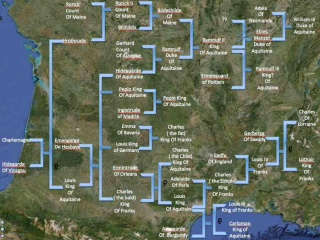 The Later Carolingians. Charles The Fat was replaced by Eudes, Charles the simple was replaced by Robert. By 774 Pipin had been recognised by the Pope as King of the Franks. The remaining Merivingian kings were disposed of, Dagobert II was murdered and both Childeric III and his son theuderic were forced into a monastery and possibly castrated to prevent the birth of any Merovingian descendants.
The Later Carolingians. Charles The Fat was replaced by Eudes, Charles the simple was replaced by Robert. By 774 Pipin had been recognised by the Pope as King of the Franks. The remaining Merivingian kings were disposed of, Dagobert II was murdered and both Childeric III and his son theuderic were forced into a monastery and possibly castrated to prevent the birth of any Merovingian descendants.
Pipin’s son Charles (Charlemagne) then set on programme of expansion which extended the Frankish empire into Saxony, Lombardy, Italy beyond the Pyrenees and of course into Aquitaine. he attempted to pursue Aquitanian rebels into Basque country but was ambushed by a joint Basque/Aquitanian force in a mountain pass at Roncelles. This was Charlemagne’s only defeat. His survival was as a direct result of the self sacrifice of once of his generals, Roland.
From that point until the end of his life Charlemagne treated Aquitaine with great respect and recognised its independence by making his eldest son King, (not Duke) of Aquitaine. within the kingdom, Waifers son Loupe became duke of gascony within the kingdom.
There then followed the rule of the Carolingian kings. During this period there was a continual recognition of the independence of Aquitaine. The Carolingian king, Charles “the fat” was judged to be unfit to rule, in view of his inability to control Viking incursions into the kingdom. Charles was deposed and replaced with Odo.
There was then a family of anti-kings, descendants of both Carolingian and Merovingian lines, who were interspersed with the later Carolingians. Eventually the Carolingians, in the person of Charles of Lorraine were overthrown by Hugh Capet, Grandson of King Robert on of the line of anti kings
The Separation of Occitan
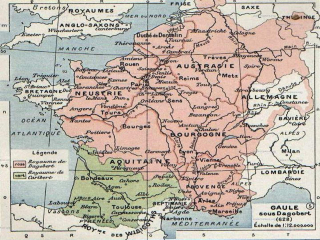 As part of the continual readjustments of borders in AD 628 the southern part of the Frankish territory became a separate “Royame”, a Kingdom, an Embryo Nation.
As part of the continual readjustments of borders in AD 628 the southern part of the Frankish territory became a separate “Royame”, a Kingdom, an Embryo Nation.
The Return of the Dukes
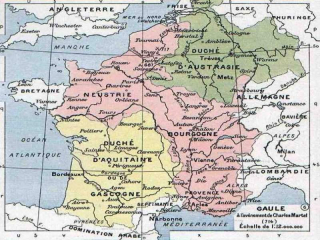 In AD 714 the concept of the Dux, now known as Dukes, and their territories as Duchies was re-established in the military hierarchy. One of the most prominent duchies was the duchy of Aquitaine now expands to include the whole of the western half of Occitan. The junior members of the royal family were named as Dukes but still required to swear allegiance to a central ruler. It introduced some stability but also another set of marcher boundaries.
In AD 714 the concept of the Dux, now known as Dukes, and their territories as Duchies was re-established in the military hierarchy. One of the most prominent duchies was the duchy of Aquitaine now expands to include the whole of the western half of Occitan. The junior members of the royal family were named as Dukes but still required to swear allegiance to a central ruler. It introduced some stability but also another set of marcher boundaries.
Overlay upon Overlay
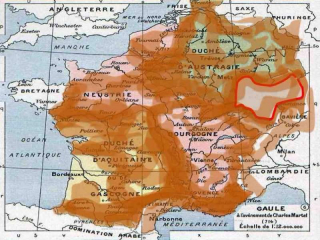 By AD800, in the areas controlled by the Frankish Kings most areas had been Marcher land at one time or another. Continuing shifts in boundaries could be almost guaranteed.
By AD800, in the areas controlled by the Frankish Kings most areas had been Marcher land at one time or another. Continuing shifts in boundaries could be almost guaranteed.
The Ramnulfids
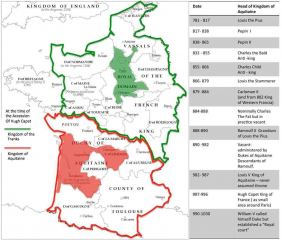 Aquitaine never accepted the anti kings and elected Ramnulf to be their King.
Aquitaine never accepted the anti kings and elected Ramnulf to be their King.
Though they ceased to use the title of king, preferring duke instead,they never gave fealty to the Capet Kings.
The Ramnulfid family became Dukes (Kings) of Aquitaine and in 1200 their possessions were greater than the King of the Franks.
The Rise of Aquitaine
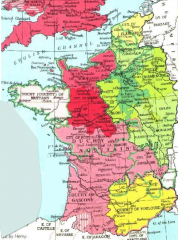 The Ramnulfid family became Dukes (Kings) of Aquitaine and in1200 their possessions were greater than the King of the Franks. They also had claim to toulouse but the Compte de Toulouse broke away and swore fealty to the Franks. This was dome when the duke of Aquitaine was away on a crusade, so in theory this action was against the laws of the Church of Rome. The Trencavels then broke away from their fealty to Toulouse. With the agreement of Richard the lionheart the swore fealty to Aragon
The Ramnulfid family became Dukes (Kings) of Aquitaine and in1200 their possessions were greater than the King of the Franks. They also had claim to toulouse but the Compte de Toulouse broke away and swore fealty to the Franks. This was dome when the duke of Aquitaine was away on a crusade, so in theory this action was against the laws of the Church of Rome. The Trencavels then broke away from their fealty to Toulouse. With the agreement of Richard the lionheart the swore fealty to Aragon
When Eleanor of Aquitaine, married Henry of Anjou who went on to become Henry II of england she carried Aquitaine into the realm of the English Crown. The difficulty was that Henry did owe fealty to the Capet Kings for Anjou and Normandy.This is what ultimately led to the hundred years war and it had absolutely nothing to do with Eleanors inheritance of Aquitaine. By this time Aquitaine included Gothia (Septimania).
From 1150 to 1337 the English kings paid homage to the King of the Franks for their property in Aquitane , Anjou, Normandy and Brittany. Over this period they gradually lost territory as marcher lords obtained better deals from the Franks.
St Gilles and Trencavel
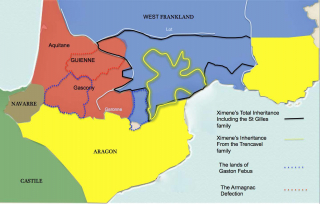 Ximene has a legitimate claim to much of what is now the departement of Languedoc Rousillion in Southern FranceThe Dukes of Aquitaine and therefore the English Kings, also had a claim to Toulouse, which had been taken from them by the the Compte de Toulouse (St Gilles family) whilst William IX of Aquitaine was away on a crusade in 1120. Incidentally this was something which according to the rules of the crusades he should not have been able to do!
Ximene has a legitimate claim to much of what is now the departement of Languedoc Rousillion in Southern FranceThe Dukes of Aquitaine and therefore the English Kings, also had a claim to Toulouse, which had been taken from them by the the Compte de Toulouse (St Gilles family) whilst William IX of Aquitaine was away on a crusade in 1120. Incidentally this was something which according to the rules of the crusades he should not have been able to do!
Encouraged by Richard the Lionheart, the Trencavels of Carcassonne, Beziers and Albi then broke away from their fealty to Toulouse and swore fealty to Aragon. The only reason they did nor swear fealty directly to Richard was that Toulouse surrounded them whereas they had a common border with Aragon. In that move the seeds of the Albigensian Crusade were laid.
In the feudal pyramid, The Trencavels, originally Comptes of Albi were definitely second tier. After the transer of allegience to the Franks they found themselves the vassals of the Comptes of Toulouse, whereas for a period they had been equals . From 1100 to 1200 they extended their influence, mainly through marriage, until they controlled about half of the St Gilles empire but still gave allegence to Toulouse and therefore to the Franks.
The switch of fealty to Alfonso of Aragon and therefore away from the King of the Franks, raised their feudal profile This was the real reason The king of the Franks wanted to depose Raimond – Roger Trencavel ; to regain lost territory.
However it is also true that the younger sons of northern lords were hungry for land, anyone’s land. They were only searching for a way of legitimising their theft.
Of course the the official reason and the reason the invasion claimed to be a crusade was that the inhabitants of the Trencavel and St Gilles lands were wicked heretics. they held the cathar faith ,that very different version of Christianity.
The Plantagenets
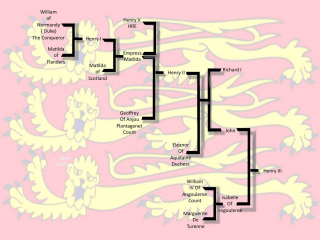 The ramnulfids became known in England as the plantagenets and The schism between them and the Kings of the Franks became the focus for the instability creating a feud which became “The Hundred Years War”.
The ramnulfids became known in England as the plantagenets and The schism between them and the Kings of the Franks became the focus for the instability creating a feud which became “The Hundred Years War”.
